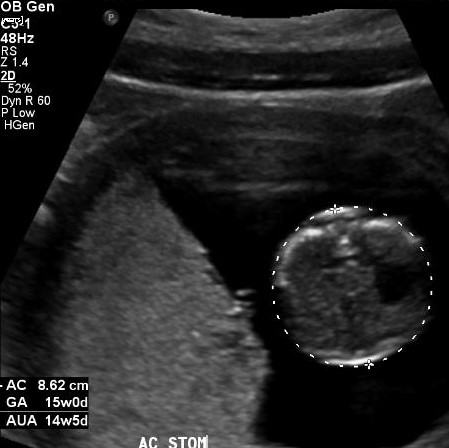
This is a good measurement of the abdominal circumference. It satisfies a number of criteria:
- the abdomen is not foreshortened (true axial measurement)
- the full circumference of the abdominal wall is visible
- the callipers are placed at the level of the skin (not deep to the ribs)
- the gastric bubble can be seen
The other landmarks, the umbilical vein and portal sinus, could not be seen in this fetus, presumably due to early age. At the standard 18-20 week exam, these structures would have to be identified.

This diagram shows the landmarks for the fetal abdominal circumference measurement 1:
fetal stomach
umbilical vein
portal sinus
The measurement callipers (dashed red line) should be on the skin surface, and not deep to it. The full circumference of the abdominal wall should be seen before measuring.
Original work of Matt Morgan.
Case Discussion
The fetal abdominal circumference (AC) is an important measurement when dating a pregnancy. Measuring the AC too small (the more common error) can potentially have catastrophic consequences to the course of the pregnancy.
To accurately measure the abdominal circumference, certain criteria have to be satisfied:
- the abdominal image should be a true axial (i.e. no foreshortening)
- the full circumference of the abdominal wall should be visible (ideally)
- the measurement should be around the skin surface (not deep to the skin)
- three landmarks should be visible (depending on fetal age)
- fetal stomach
- umbilical vein
- portal sinus




 Unable to process the form. Check for errors and try again.
Unable to process the form. Check for errors and try again.